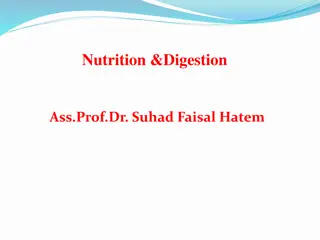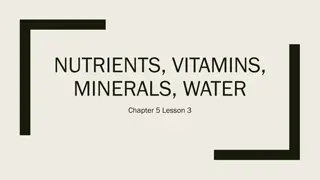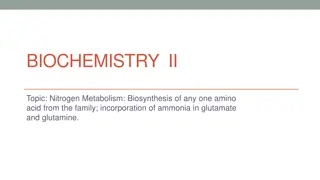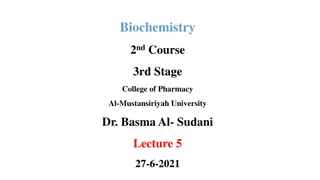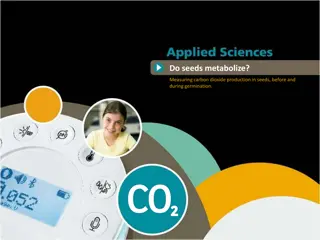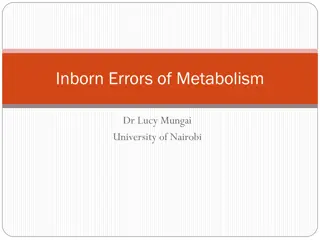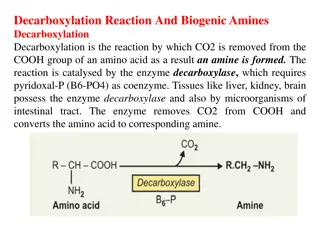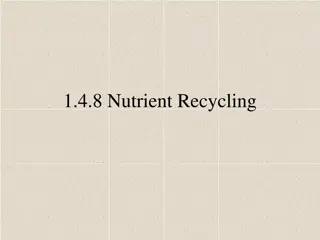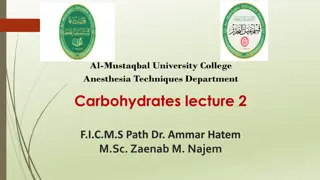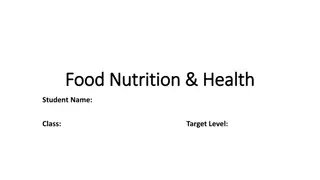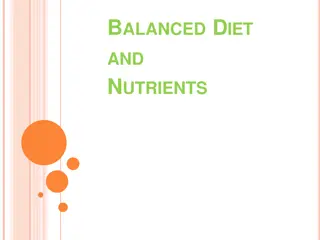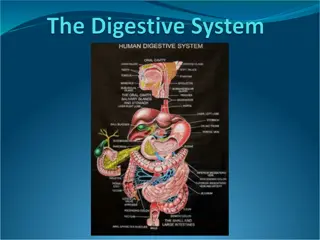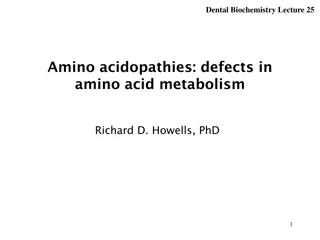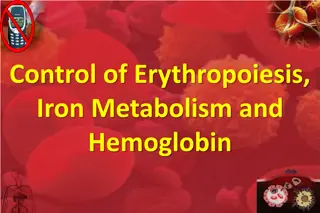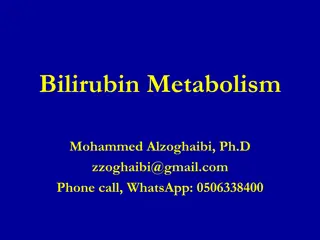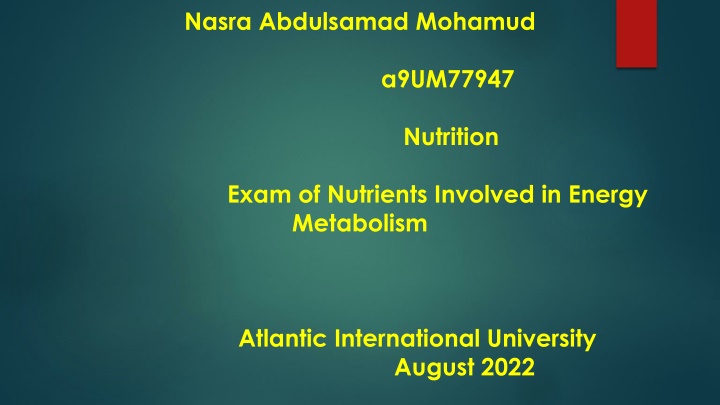
Energy Metabolism and Nutrients' Role
Explore the significance of energy metabolism in human physiology and the crucial role of nutrients such as B vitamins in energy production. Learn how macronutrients are converted into usable energy through complex metabolic processes, highlighting the pathways involved in ATP production. Discover the impact of oxidative phosphorylation on ATP synthesis and the potential consequences of uncoupling proteins on energy expenditure.
Download Presentation

Please find below an Image/Link to download the presentation.
The content on the website is provided AS IS for your information and personal use only. It may not be sold, licensed, or shared on other websites without obtaining consent from the author. If you encounter any issues during the download, it is possible that the publisher has removed the file from their server.
You are allowed to download the files provided on this website for personal or commercial use, subject to the condition that they are used lawfully. All files are the property of their respective owners.
The content on the website is provided AS IS for your information and personal use only. It may not be sold, licensed, or shared on other websites without obtaining consent from the author.
E N D
Presentation Transcript
Nasra Abdulsamad Mohamud a9UM77947 Nutrition Exam of Nutrients Involved in Energy Metabolism Atlantic International University August 2022
Introduction Energy metabolism is the most significant bodily process and influences energy expenditure. It is critical to human basal metabolism, growth, and physical activity. Energy obtained from nutrition is required for living and drives important cellular activities in humans. Chemical energy held in macronutrients (carbohydrate, fat, and protein) is converted into various forms of energy such as heat and adenosine triphosphate via complicated metabolic processes. At the cellular level, metabolism is regulated by a sophisticated neuro hormonal system that responds to a range of stimuli and affects substrate use in individual cells. The overarching goal of this regulatory mechanism is to maintain energy balance, therefore it is critical to comprehend the routes that transform food into useable energy. (1)
Thiamin, riboflavin, niacin, pantothenic acid, and biotin are mostly coenzymes. In this capacity, they activate enzymes and aid in the energy metabolism of carbohydrates, lipids, amino acids, and alcohol; fatty acid and cholesterol production; and gluconeogenesis.(2) Whole grains, fortified breads, ready-to-eat cereals, meats, dairy products, and various fruits and vegetables are all good sources of B vitamins.(2) B vitamins play so many key functions in energy metabolism, marketing claims that B vitamins improve energy and performance are prevalent.
Summary of energy metabolism Once in the body, the macromolecules present in meals undergo a series of degenerative processes that provide the substrates required to encourage the continuance of an energy metabolism process. The end outcome of this incredibly precise chain of chemical and biological processes is the translation of free energy into energy that the human body can completely utilize. Carbohydrates are broken down into simple sugars, fats into fatty acids, and proteins into amino acids. The full oxidation of these molecules eventually creates acetyl CoA, which serves as a connection to the TCA cycle. Acetyl CoA is completely oxidized to CO2 and H2O in the TCA cycle. Hydrogen atoms and their electrons are released during the cycle. After that, The hydrogen atoms are then bound to other compounds, resulting in the production of three molecules of NADH, on
one FADH2, and one GTP. These new molecules contain the energy originally found in acetyl CoA. For the production of ATP, NADH and FADH2 carry the electrons from the TCA cycle through an electron transport chain known as oxidative phosphorylation. The process ends with the production of ATP and H2O. An alteration in oxidative phosphorylation can impair the production of ATP and dissipate energy as heat instead. Uncoupling proteins are responsible for this. (3)
Course personal feedback: I have experienced a vitamin b deficiency for a months. In this period I was complaining from hair lost, fatigue and a light sleep. After I took 2 months of vitamin supplements everything turned out alright. All upcoming photos adapted from google.
Deficiency of nutrients intake B vitamins function as coenzymes and are required for the conversion of carbs, lipids, and proteins into energy. The energy source material ATP (adenosine triphosphate) becomes the driving power for moving the muscles during exercising. It is critical to acquire a healthy mix of B vitamins for your body to be able to break down carbs and fats and maintain ATP synthesis. The symptoms of a vitamin B deficiency change depending on whatever B vitamin a person is low in, resulting in a variety of symptoms. They might range from tiredness and disorientation to anemia and a weakened immune system. Rashes on the skin are also possible.To treat a B vitamin deficiency, your doctor will most likely advise you to take supplements or increase your intake of foods containing the target vitamin.
Beriberi, A disease caused by thiamin deficiency. Ariboflavinosis, A condition caused by riboflavin deficiency. pellagra ,A disease that results from severe niacin deficiency. (2) Vit b Deficiency can also increase susceptibility to infections, cause fatigue, lack of energy, and impair attention. Persons on calorie-restricted diets, people with unbalanced or inadequate nutrition, people with eating disorders, and people experiencing high levels of physical or mental stress are the groups most at risk for a lack of any of these micronutrients.1
Answers of chapter 8 1. The B-vitamins include (d. thiamin, pantothenic acid, and biotin.) 2. Which of the following statements about choline is true? b. Choline is a B-vitamin that assists in homocysteine metabolism 3. According to the World Health Organization (WHO), the greatest single cause of preventable brain damage and mental retardation in the world is a. iodine deficiency. 4. Which of the following lunches provides the highest levels of thiamin, riboflavin, niacin, and vitamin B6 ? b. tuna sandwich on whole-wheat bread, green peas, banana, 1 cup of low-fat milk
5. Which of the following statements is true of riboflavin? d. It is water soluble. 6. True or false? There is no DRI for sulfur. (T) 7. True or false? Biotin is a B-vitamin. (T) 8. True or false? Iodine is necessary for the synthesis of thyroid hormones. (T) 9. True or false? Wernicke Korsakoff syndrome is a thiamin deficiency related to chronic alcohol abuse. (T) 10. True or false? In the United States, milk is fortified with riboflavin to prevent pellagra. (F) 11. Would you expect goiter to be more common in coastal regions or inland? Explain your answer.
Inland areasBecause they consume less seafoods rich in iodine. 12. Explain the statement that, without vitamin B6 , all amino acids become essential. Vitamin B6 is important in the transamination of essential amino acids to nonessential amino acids. 13. Aaron eats only whole, unprocessed foods and beverages. He asserts that we would all be better off if we ate foods fresh off the farm instead of allowing our food industry to spray foods with factory-produced vitamins and minerals. Do you agree with Aaron s position? Why or why not?
14. Your great-aunt is on renal dialysis. Explain the implications, if any, for her B-vitamin status. Dialysis can remove water-soluble vitamins from the blood, which need to be replaced with either foods high in these nutrients or supplements. 15. Sally is 35 years old and has always been energetic; however, lately she has been feeling exhausted. She can hardly get out of bed in the morning even after 8 hours of sleep. She has attributed this fatigue to the fact that she has been dieting for weight loss for the last 6 months and is using a low- sodium, low-calorie vegan diet (1,000 kcal/day) that she also hopes will help reduce her blood pressure. She is eating lots of fruits and vegetables, but little else. Although she knows it is important to exercise for weight loss, she is too tired. What do you think might be contributing to Sally s fatigue? Of the micronutrients discussed in this chapter, which ones might be low in her diet? How might they contribute to fatigue?
Iodine deficiency, can cause fatigue and also can lead to hypothyroidism (low thyroid hormone levels in the blood), which is characterized by low body temperature, difficulty to tolerate cold temperatures, weight gain, and sluggishness. (2)
conclusion The conversion of the chemical energy of fuel molecules into useable energy is highly regulated, and various variables influence how different cells use glucose, fatty acids, and amino acids. For example, not all cells contain the enzyme machinery and cellular compartments required to utilise all three fuel molecules. Red blood cells lack mitochondria and hence cannot oxidize fatty acids or amino acids, relying instead on glucose for ATP generation. Furthermore, even in cells that can utilise all nutrients, the kind of food substrate that is oxidized changes depending on the cell's physiological state, such as fed or fasting. Different cues, such as hormones, influence how cells adapt to different situations.(3)
Inadequate B-vitamin levels can impair an individual's capacity to engage in physical exercise. A diet heavy in processed foods usually delivers insufficient quantities of B-vitamins. Megadoses of various B-vitamin supplements can cause toxicity.(2)
bibliography (1) J.A. Coss-Bu, N.M. Mehta, in Encyclopedia of Food and Health, 2016 [2] J. Thompson, M. Manore, L. A. Vaughan. The science of nutrition/Janice L. Thompson, Melinda M. Manore, Linda A. Vaughan. 2011. (3) S. Rubinstein-Litwak, in Encyclopedia of Food Sciences and Nutrition (Second Edition), 2003


